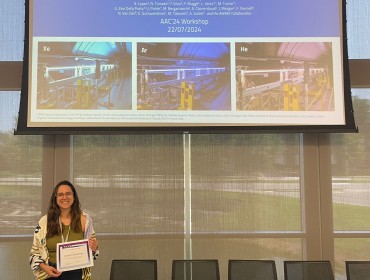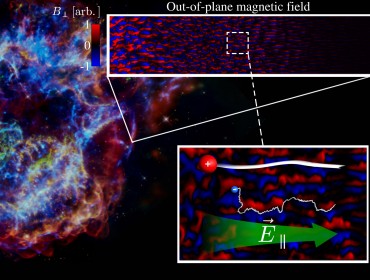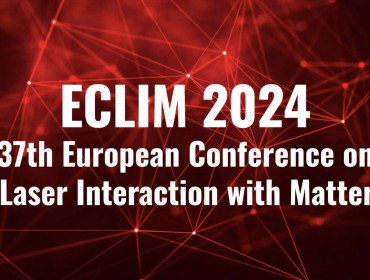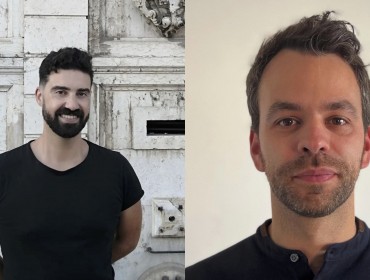-
GoLP team members attend 66th Annual Meeting of the APS Division of Plasma Physics
Read moreSome of our GoLP members went to Atlanta, Georgia USA to attend the 66th Annual Meeting of the APS Division of Plasma Physics, held on 7-11 October 2024, and presented a talk about their recent work.
In the first picture: Frederico F, Diogo C, Paulo A, Bernardo B, Thales S, Kevin S and Luis G.Here, are some pictures from the event:
October 16, 2024 -
José M received scholarship to support his studies in Quantum Computing
Read moreJosé M, a master’s student in epp, has been awarded the ‘Talentos Quânticos’ scholarship. This initiative by the Portuguese Quantum Institute is designed to support young researchers in the field of Quantum Science and Technologies, including Quantum Computing, by providing financial assistance for research on a related topic. Congratulations to José!
October 16, 2024 -
ECLIM 2024 at IST
Read moreLast Saturday, the 37th European Conference on Laser Interaction with Matter (ECLIM 2024) was successfully concluded. GoLP was part of the organization and some team members also presented their work. Our GoLP members Sofiia P, Lucas A, Lucas I, Óscar A, Zahra M, Pablo B, Robert B, Bernardo B, Camilla W, Rafael A, Anthony MB and Filipe DC presented a poster, while Chiara B, Thales S, Thomas G and Marija V gave a talk.
Here are some pictures from the event:
September 23, 2024 -
Epp members at 21st International Congress on Plasma Physics in Ghent
Read moreOur team members Róbert Babjak and Thales Silva attended the 21st International Congress on Plasma Physics held on 8th to 13th September in Ghent, Belgium, to present invited talks about their recent work. Thales presented his recent results on the generation of unstable plasmas with laser-matter interactions and Róbert presented his results on direct laser acceleration mechanisms and its possibility as a high-brilliance gamma-ray source.
September 17, 2024 -
GoLP and IPFN Collaborator Marco P Wins €1.5M ERC Starting Grant for Pioneering Laser Research
Read moreMarco Piccardo, a key collaborator of GoLP (Group of Lasers and Plasmas) and IPFN, as well as a professor at Instituto Superior Técnico and researcher at INESC-MN, has been awarded a prestigious €1.5 million ERC Starting Grant. His cutting-edge “metaPOWER” project will explore high-power laser-plasma interactions using meta-optics, with some experimental work to be carried out at GoLP. This research holds potential for advancements in fusion energy, particle acceleration, and radiation sources combining high intensity lasers and plasmas.
More information here.
Links also to Physics Department, and INESC-MN.Foto by Maria Carolina | Instituto Superior Técnico
September 6, 2024 -
Epp team members awarded 20 million core-hour allocation at Marenostrum V
Read moreEpp team members were awarded with a 20 million core-hour allocation at the TIER-0 supercomputer Marenostrum V at the Barcelona Supercomputer Center. The allocation was granted by Rede Nacional de Computação Avançada (RNCA). The project “Modeling Extreme Plasma Accelerators and Light Sources” will investigate advanced plasma accelerators and light sources in combination with structured light, focusing on high-quality electron acceleration and superradiant emission in plasma-based accelerators.
September 5, 2024 -
Best Student Poster Award for PhD student Carolina A at AAC24
Read moreDuring the Advanced Accelerators Concepts Workshop 2024 our PhD student Carolina Amoedo won the Best Student Poster Award. She received this award by presenting the work “Demonstration of proton bunch self-modulation in a discharge plasma source”. Many congratulations to Carolina!
July 29, 2024 -
GoLP Awarded 9 Million CPU Hours on Leonardo Supercomputer
Read moreOur research group has been awarded 9 million CPU hours on Cineca’s Leonardo supercomputer in Italy. This significant allocation in Leonardo, one of Europe’s leading supercomputers, will support our efforts in the understanding of plasma instabilities in exotic scenarios. The allocation is led by Thales Silva as PI.
Figure: Simulation result of the magnetic field from the Weibel instability in exotic plasmas
July 25, 2024 -
Jorge V speaking about plasma accelerators on Antena 1
Read moreJorge V, research member of GoLP, will be talking about his work on ’90 segundos de ciência’. In this interview, Jorge will speak about plasma accelerators, starting from their advantages to their possible applications. The episode will be streamed on the 23rd of July, at 5 pm (WET) and with a replay on the 24th of July at 11 am (WET).
July 15, 2024 -
Lunar Mini-Magnetospheres: New Insights into Magnetic Reconnection
Read moreIn a study published in The Astrophysical Journal, researchers from the University of California, Los Angeles, and the Instituto Superior Técnico, Universidade de Lisboa, have investigated magnetic reconnection in lunar-relevant mini-magnetospheres. The team, including Filipe D. Cruz, Fábio Cruz, and Luis O. Silva from the Instituto Superior Técnico, used advanced laboratory experiments and particle-in-cell simulations using the code OSIRIS to uncover critical insights into the microphysics of collisionless space plasmas. Their findings reveal the formation of Hall fields and electron-only reconnection driven by kinetic effects, contributing to our understanding of space plasma dynamics near the lunar surface.
July 10, 2024 -
GoLP member Thomas Grismayer has received an honorable mention in "the University of Lisbon/Caixa Geral dos Depósitos Scientific Awards competition" - Edition 2024.
Read moreThe University of Lisbon (ULisboa), with the support of Caixa Geral de Depósitos, awards the annual University of Lisbon/Caixa Geral de Depósitos Scientific Awards, which aim to reward scientific research activity and encourage the practice of international publication of recognized quality and impact.
Some pictures from the event:
June 26, 2024 -
Firing up the interstellar space
Read moreWhen stars explode, their remnants drive violent shock waves that heat electrons in the interstellar medium to three orders of magnitude above the temperature expected from adiabatic compression on the shock. The mechanisms behind this heating have remained a long-standing puzzle.
In a new article published in the prestigious Physical Review Letters, Frederico Fiuza, professor at the Physics Department and principal investigator at the Group of Lasers and Plasmas of the Institute for Plasmas and Nuclear Fusion of IST, and colleagues present a new theory for the energy partition between electrons and ions in such strong shock waves.
Initially, most of the energy in these shocks is carried by the ions, which are much heavier than electrons. Because these shocks are collisionless, meaning that Coulomb collisions between particles are negligible, collective electromagnetic processes must be responsible for exchanging energy between the ions and the electrons at the shock. The…
June 26, 2024 -
Successful Generation of Electron-Positron Plasmas: New Paper Published and Featured in Público
Read moreThe experimental results from the Fireball (HRMT-62) project, achieved last year at CERN’s SPS HiRadMat facility, have now been published in Nature Communications and featured in the prominent Portuguese newspaper, Público. Our team, including Filipe Cruz, Pablo J. Bilbao, and Luis O. Silva, played a key role by providing numerical simulations that helped design the experimental platform. Under the leadership of Charles Arrowsmith and Gianluca Gregori from Oxford University, the project brought together researchers from institutions such as Lawrence Livermore National Laboratory, Rochester University, University of Iceland, Max Planck Institute, and IST, showcasing a strong international collaboration.
The experiment focused on generating high-density, quasi-neutral electron-positron plasmas by directing a 440 GeV/c proton beam at a specially designed target. This effort marks a significant milestone, as it is the first successful creation of such plasmas in a controlled laboratory setting. The data collected revealed that the generated electron-positron beams…
June 26, 2024 -
New publication in PRL by GoLP members demonstrates high-charge alternative to laser-wakefield acceleration
Read moreA team of researchers from IST has recently published a paper entitled: “Direct laser acceleration in underdense plasmas with multi-PW lasers: A path to high-charge, GeV class electron bunches.” in the prestigious journal Physical Review Letters. The work was done in collaboration with researchers from the University of Michigan and University of California San Diego.
The most powerful lasers in the world can accelerate electrons to extreme energies, making them almost as fast as light. To accomplish this, it is necessary to ensure stable propagation of such laser pulses over tens of centimetres of plasma, which can be very challenging. By changing the acceleration strategy, the team has demonstrated how to reduce the typical acceleration distance to just a few millimetres and identified the possibility of accelerating a thousand times more particles than in other laser-based schemes. This micro-accelerator holds a potential to decrease the cost and size of…
June 20, 2024 -
Epp members awarded 40 million core hours in Deucalion
Read moreThe epp projects PILARS: Particle and intense-laser interactions, acceleration, and radiation sources and Masers in Astrophysical Plasmas (MAPs), led by PIs Lucas Ivan Iñigo Gamiz and Pablo J. Bilbao, respectively. Have been awarded a total of 40 million core hours at the newest and largest supercomputer in Portugal Deucalion jointly funded by FCT and the European HPC Joint Undertaking. Both projects were among the top 4 projects submitted. They were selected due to the relevance of the topic, the cutting-edge methods available to the researchers at GoLP, and the expertise within the group.
The projects aim to study plasmas under extreme conditions in the laboratory and astrophysics. The PILARS project will investigate novel ways of accelerating electrons to high-charge, accelerating positrons, seeding of QED cascades, and provide reproducible experimental schemes for the up-and-coming commission of next-generation petawatt laser facilities. MAPs aims to study how plasmas can produce coherent radiation relevant to…
May 23, 2024 -
Epp project selected as EuroHPC Success Story
Read moreThe computing project led by epp team member J. Vieira was selected as a Success Story of the EuroHPC Joint Undertaking. The project, titled ‘Plasma Accelerator-Based Light sources’, focused on the possible use of collective plasma motion to emit very bright radiation. Project highlights include using structured light to enhance ion acceleration (lead by epp team member C. Willim, published here in Physical Review Research); a new mechanism to mitigate the hosing instability in plasma accelerators (lead by former epp team member M. Moreira, published in Physical Review Letters); and a superradiant quasiparticle light sources in plasma accelerators , which leveraged the Radiation Diagnostic for Osiris (https://doi.org/10.1016/j.cpc.2022.108634, also check the video).
A plasma wave (in blue) excited by a laser can travel at speeds faster than the speed of light, generating bright single-cycle light…
May 17, 2024 -
GoLP Research Featured in Physics of Plasmas
Read moreA recent paper by GoLP researchers has been chosen as Editor’s Pick in the American Institute of Physics’ (AIP) journal Physics of Plasmas. This distinction recognizes the research’s potential impact, clarity, and overall quality. The study explores the behavior of plasmas under extremely powerful electromagnetic fields, encountered in both labs with ultra-intense lasers and around celestial objects like pulsars and magnetars. The team’s findings reveal that radiation emitted from hot plasmas in such fields can alter their equilibrium state. These results may hold the key to explaining puzzling astrophysical observations, suggesting a different behaviour for plasmas surrounding these objects than previously thought.
May 16, 2024 -
ECLIM 2024 in September at IST (Lisbon)
Read moreECLIM 2024 – 37th European Conference on Laser Interaction with Matter, is set to be held the 16-20th of September 2024 in Lisbon (Portugal). The Conference setting will be the IST Congress Centre, Instituto Superior Técnico, Alameda Campus, Lisbon.
ECLIM is a biennial conference hosted in Europe representing, since its first edition in 1966, a historic meeting for scientists working on the physics of laser-matter interaction with emphasis on laser fusion, laser-produced plasmas, particle generation and acceleration, laser-driven X-ray and EUV sources. The Conference is aimed to stimulate the development of research in the broad field of laser-matter interactions using high-power lasers, offering the opportunity to present and discuss new results and projects in a rather informal atmosphere.
The Conference topics include:
Physics of laser-matter interaction
Laser-generated plasmas
Laser-plasma particle accelerators
High-intensity Laser Facilities
Physics of structured light
Attosecond laser pulses
XUV sources and HH generation
Progress on Laser Fusion
HIPER+ Initiative
Physics of thermonuclear targets
Theory of laser-matter interaction
QED laser physics
Laser and…
May 10, 2024 -
Frederico F and Hugo T elected for the Seminario dos Jovens Cientistas of the Lisbon Academy of Sciences
Read moreGoLP’s members Frederico F and Hugo T were elected for the Seminario dos Jovens Cientistas of the Lisbon Academy of Sciences. The group aims to develop different activities to promote science in society and politics, including organizing scientific and academic events.
About the election, Frederico F said: “This election is a great honor. I hope to contribute to the mission of the Academy and, in particular, help strengthen the connection between the scientific community and society.”
Hugo T added: “I have received this distinction with great surprise and honour. It is certainly a privilege to actively participate in discussions about the future of science in Portugal and its relations with the actual policies. It will be a great opportunity to understand the directions we should take with an open but critical spirit.”
March 11, 2024 -
PhD position(s) in extreme plasma physics 2024
Read moreDuring a 4-year period, perform original research in the team of Prof. Luis O. Silva, combining theory and simulations (the balance will depend on the specific PhD project), and, for some of the projects, be involved in experimental collaborations. Some part of the PhD project (6 months to one year) to be developed abroad.
Possible topics are (but not limited to): QED plasma kinetics and coherent radiation processes in ultra strong fields, fireball beams and particle acceleration, HPC/AI for kinetic plasma simulations, control of laser-plasma topology and instabilities, laser fusion, exotic beyond-electroweak plasma dynamics and instabilities.More information click here.
February 7, 2024
Group for Lasers and Plasmas > News




























